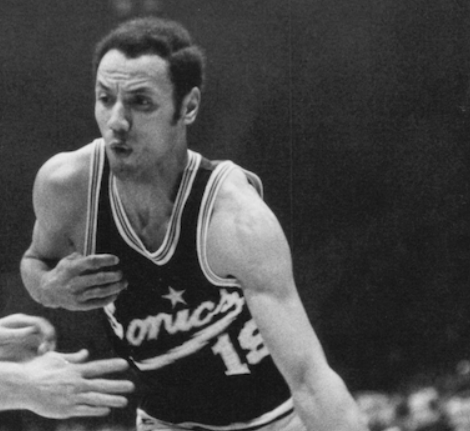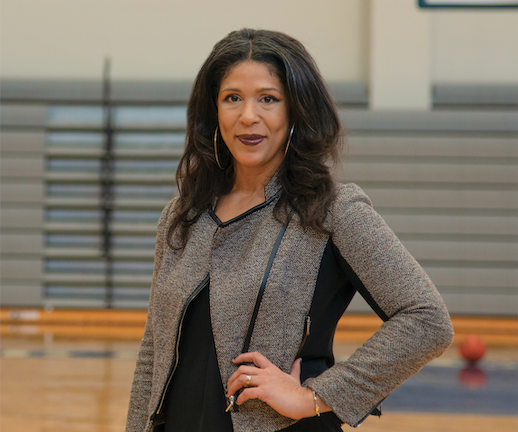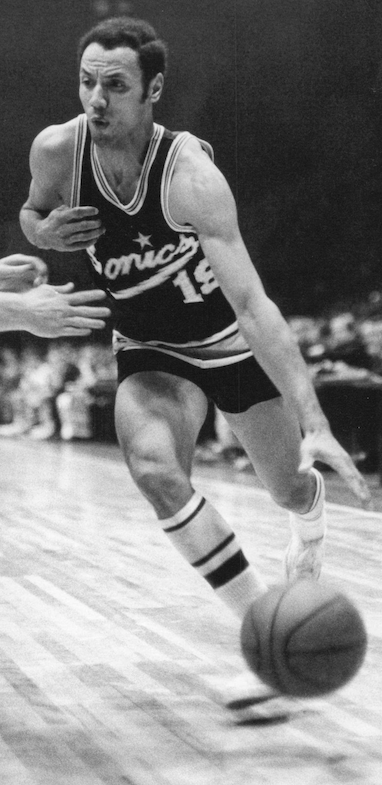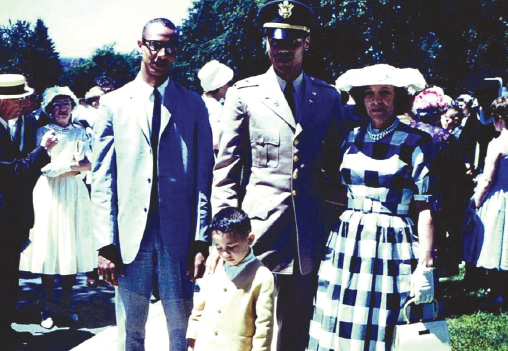The Coach and I

Terry Anne Scott, Ph.D., assistant professor of American history, shares her firsthand relationship with NBA legend Lenny Wilkens.
The Coach and I | Hood Magazine, Spring 2019
Lenny Wilkens and I first met in 2013 when he spoke in my course on the history of African Americans and sports at the University of Washington. After he became a regular speaker in my class, he asked if I would write his biography. What a daunting task! How can I do his life justice? Despite my nearly debilitating self-doubt, I agreed to conquer the seemingly impossible. As a result of my odd mix of self-doubt and nearly boastful acquiescence, I am in the process of completing two works that focus on the incredible life of Lenny Wilkens. I am the editor of the forthcoming anthology Seattle Sports: Play, Identity, and the Pursuit of Credibility in the Emerald City. I am also the author of the chapter in the work that focuses on Wilkens’ tenure with the Seattle SuperSonics. My second work related to Wilkens is the biography that he asked me to write. From Bed-Stuy to the Hall of Fame: The Unexpected Life of Lenny Wilkens will be released in 2020.
Wilkens was not expected to do well in basketball, much less in life. The future three-time Naismith Hall of Famer (inducted as player, coach, and member of the Dream Team coaching staff ) grew up in tenement apartments in the Bedford Stuyvesant, or “Bed-Stuy,” section of Brooklyn. Trouble loomed large in the urban complex by the time of Wilkens’ birth on October 28, 1937. Situated in the north central portion of New York’s most populous borough, Bed-Stuy was home to gangs, violence, and other perils attendant to economic hardship.
“I know what it means to be on welfare,” Wilkens once averred. “I know what it means to have a stranger in the house, snooping around, checking to see if you are hiding something.”
When Wilkens was five years old, his father passed away. Wilkens’ mother had to raise four small children on her own while working at a candy factory. “No matter how hard she worked,” he remembered, “there was never enough money, enough time, enough energy.”
Despite his humble beginnings and less than spectacular entre into basketball (he only played half of a season for his high school team), Wilkens became one of the greatest players and coaches in NBA history, but not by his own admission. His seemingly innate humility forbids such a boasting. It is this unique self-effacement that defines his character in ways constantly revealed, and almost always surprising.
As a player, the six-feet-one-inch tall, left-handed guard was unrelenting in his pursuit of the basket. “No one was going to stop me. They could try, but they were not going to stop me,” intoned an unwaveringly determined Wilkens. As a coach, he was nurturing when necessary, stern but fair in all instances, exacting on the court and a sage for players off of it. His penchant for winning came second only to his desire to effect change among economically marginalized individuals in his local communities.
I was determined to understand how a kid who was ranked number fifteen of fifteen on his high school basketball team his freshman year—a poor, black kid from Brooklyn, raised by a single mother and coming of age when racial discrimination was still sanctioned by the federal government— could become the great basketball Hall of Famer, and quiet philanthropist, Lenny Wilkens.

For our first several conversations, I met Wilkens at a neighborhood coffee shop near his home in Medina, an affluent suburb across Lake Washington from the city of Seattle. It was a quaint shop with a fire place in the far corner of the standalone building that created a warm, comfortable setting—an unostentatious space where Wilkens felt content. Everyone present knew who he was despite the cover of his low sitting baseball cap that lent partial asylum to his identity. He was recognized and respected—both would fall from the lips and show in the demeanor of local admirers every step Wilkens took. I was enthralled by the deference and adoration shown to him: “Hi, Coach.” “Hey, Coach.” “Mr. Wilkens, you don’t know what you mean to me.” The esteem was endless, and with each stream of love, each expression of reverence, Wilkens maintained the same quiet humility and reciprocal respect: “Thank you.” “How are you today?”
It was in a corner of that picturesque shop that I first queried Wilkens about the origin of his resolve, the root of his inestimable perseverance in the face of cruel obstacles. Through his lingering Brooklyn accent that dropped the –er in favor of a warmer –uh, Wilkens insisted that his “mothuh” imbued his character with an unshakable determination to persevere. His success was expected—Wilkens’ mother made sure that he and his siblings fully understood that.

The following excerpts are taken from a chapter on Wilkens in Seattle Sports. The first explores his father’s influence on his life.
Although born to an Irish mother, Wilkens and his siblings would largely be defined by the race of their father. “When my mother would take us shopping, we were the color of the rainbow,” Wilkens jeered. “People would look,” he recalled, “She would turn around and ask them what they were looking at.” His mother, never one to tolerate disrespect—much like her son—understood that her children would encounter discrimination in a racially oppressive America. She made sure that Wilkens was fully aware that he was growing up as a black man in a racially oppressive society, despite his Irish heritage. A priest once queried Wilkens about his racial heritage: “What’s it like to have a foot in both worlds?” The question seemed somewhat odd to Wilkens. He was fully aware at a young age that he was biracial, but, when asked to fill in his race on a form, “I’d write I was African-American.” He knew (perhaps subconsciously, even instinctually, at first, but with intentional fortitude as he grew into adolescence) that he could either relax into a nihilistic existence in which a debased, racialized status was internalized, only to become crestfallen and discouraged, or, he could emerge as a victor in all things. He chose the latter. Wilkens worked tirelessly to be the best, determined to overcome any obstacle presented to him throughout his lifetime, and to bring about equity for others in the process.
“On my desk, there’s a picture of my father,” he writes in his autobiography. His admiration for his father eclipses all time and space, serving as both prologue and primer for Wilkens’ life: “He’s a man I never really knew, yet a man who feels very much a part of me today. The man staring at me is always about thirty-five, always in the prime of life, dark-skinned, strong, healthy. He’s the father I wished was there when my team in Seattle won the 1979 NBA title, the father I wanted with me when I was inducted in the Basketball Hall of Fame…He’s the father I wished could see my children and meet my wife, Marilyn.” Over the years, Wilkens’ extended family has found parallels in his disposition and that of his father: “I [am] in control, calm. I [don’t] get too excited about things but always [seem] to be in control of what I [am] doing.” Even in his absence, Wilkens father shaped him in enduring ways.
In 1960, the NBA St. Louis Hawks drafted Wilkens. The racism that existed in St. Louis would challenge Wilkens in ways he had never before experienced. The following excerpt explores Wilkens’ early encounters in the city.
Highly visible athletic success typically affords one a certain notoriety, a lionized existence that allows the sports star to be treated as a celebrity. Yet, the social mores of a particular historical moment are often reflected in the interplay between race and athletics. Therefore, even celebrity standing was not strong enough at particular times in our nation’s history to overcome the debased status of blackness. This is why Wilkens could be cheered for in St. Louis’ Kiel Auditorium during a game one evening, but was unwelcomed at local restaurants the following day because of his race. Despite his light skin and dual racial heritage, people were fully aware that he was not white. St. Louis was a segregated city when Wilkens was drafted by the Hawks. The storefronts did not don “For White Only” or “No Colored Allowed” signs as they did in other segregated spaces. Wilkens was somewhat familiar with such signs; he first witnessed them when traveling by bus through Virginia while playing for Providence College. He was also familiar with the rage and ridiculous fear engendered by his race. St. Louis would nonetheless exist as a new world for Wilkens, one whose racial restrictiveness would align the city with many other areas across the country, but would stand as something wholly apart from Wilkens’ childhood home where he was friends with children from various racial and ethnic backgrounds. He had felt the contemptuous stares of onlookers in New York when his mother took him to certain stores. He had dealt with racist school administrators who warned him to stay away from white women. None of this was new to Wilkens, but within the boundaries that defined his part of Bed-Stuy, he had been largely removed from the abject racism extant across other parts of the country at the time. In the absence of Jim Crow signage, St. Louis’ segregated mapping was accomplished through icy reception in public spaces, refusal to seat African American patrons at restaurants or serve them at stores, “white flight,” and, not infrequently, violence.

While always insulting, at times, the irony of racism in St. Louis was particularly glaring. “There was a cafeteria-style restaurant that had pictures of several Hawks players in the window, including me,” Wilkens remembered. “Everyone knew the restaurant only served whites, but there was my picture. They thought I was good enough to be in their window and maybe help bring in business, but I wasn’t supposed to eat there,” he added while alluding to the galling hypocrisy. One evening, he decided to test the restaurant’s gull and push back against the boundaries of racism. He stood in line and waited to be served. Had they refused to serve him, he was ready to strike back regarding the effrontery required to use him to solicit customers, but refuse him service. The restaurant avoided any confrontation and instead served Wilkens. “Everyone was staring,” he remembered, “but no one had the guts to challenge me.”
By his second season with the team, Wilkens was married and Marilyn, his wife, was pregnant. They were ready to vacate their apartment and purchase a home for their growing family. By the time the Wilkens searched for a house in St. Louis, racial restrictive covenants that had once barred African Americans from living in various portions of the city were no longer legal. White residents who opposed the presence of African Americans in their neighborhoods would find other ways to register their contempt. The Wilkens purchased a house that had been repossessed by the bank in Moline Acres, a white, middle class suburb established in 1949. Wilkens and a friend did the repairs on the edifice themselves without incident. None of the neighbors said anything to them as they worked. Wilkens reasoned later that they must have assumed he and his friend were simply construction workers, and not their new neighbors. Then, the Wilkens moved into their newly purchased, renovated home, a move that prompted many of their white neighbors to abscond from a neighborhood that now had a black family in it: “The FOR SALE signs popped up, one after another after another,” Wilkens recalled. “No one came to the house to meet us. No one knew, or cared, that I played for the St. Louis Hawks. It didn’t matter that we’d put a lot of work into the house and had it in better shape than it had been for years,” he shrugged. Nor did it seem to matter that he and Marilyn were college educated. The neighbors were almost scornful of the fact that he and his wife had “solid values who just wanted a nice, safe place to live” and that they “could afford to buy the house,” Wilkens noted. The seeming height of racism was reached when the Wilkens’ collie, Duchess, was poisoned by neighbors. Instead of encouraging the couple to flee, the incident redoubled their resolve to stay: “No one was going to scare us, to run us off. We had as much right to live on that street as anyone.” ■
Terry Anne Scott, Ph.D., is an assistant professor of American history, whose research and teaching interests focus on urban history, the intersection of race and sports, and African American social and cultural history.
Are you ready to say Hello?
Choose a Pathway
Information will vary based on program level. Select a path to find the information you're looking for!
